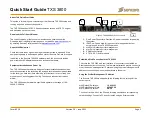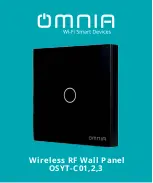
Standard Output
Polarity must be observed when connecting the signal output to the
load. The positive connection (+) is connected to terminal 7 and the
negative (–) is connected to terminal 8.
The standard API 7500 G has an open drain MOSFET (open col-
lector) output. This output requires a user-supplied external power
supply and pull-up resistor unless your input device is compatible
with this type of output. The output signal is protected to a maxi-
mum of 24 V. See wiring diagram below.
M02 Option TTL Output
The M02 TTL output option uses an internal power supply and an
internal pull up resistor. An external power supply is not needed.
The output amplitude can vary from 1 VDC to 12 VDC depending
on the input impedance of your device. Maximum current drive
capability is 10 mA.
Module Power
Check model/serial number label for module operating voltage to
make sure it matches available power.
AC power is connected to terminals 1 and 3.
For DC powered modules, polarity MUST be observed. Positive (+) is
wired to terminal 1 and negative (–) is wired to terminal 3.
Output Calibration
Input and output ranges, if specified on your order, are factory
pre-configured (at 24°C ±1°C). Top-mounted zero and span poten-
tiometers can be used should fine-tuning the output be necessary.
Note: Perform the following calibration procedure any time switch
settings are changed.
1. Apply power to the module and allow a minimum 20 minute
warm up time.
2. Using an accurate calibration source, provide an input to the
module equal to the minimum input required for the application.
3. Using an accurate frequency measurement device for the
output, adjust the Zero potentiometer for the exact minimum
output desired. The Zero control should only be adjusted when
the input signal is at its minimum. This will produce the cor-
responding minimum output signal of 0 Hz.
4. Set the input at maximum, and then adjust the Span pot for the
exact maximum output desired. The Span control should only
be adjusted when the input signal is at its maximum. This will
produce the corresponding maximum output signal.
5. Repeat adjustments for maximum accuracy.
Installation and Setup
API 7500 G, API 7500 G SS
Precautions
WARNING! All wiring must be performed by a qualified electrician or
instrumentation engineer. See diagram for terminal designations and
wiring examples. Consult factory for assistance.
WARNING! Avoid shock hazards! Turn signal input, output, and
power off before connecting or disconnecting wiring, or removing
or installing module.
Précautions
ATTENTION! Tout le câblage doit être effectué par un électricien
ou ingénieur en instrumentation qualifié. Voir le diagramme pour
désignations des bornes et des exemples de câblage. Consulter
l'usine pour assistance.
ATTENTION! Éviter les risques de choc! Fermez le signal d'entrée,
le signal de sortie et l'alimentation électrique avant de connecter ou
de déconnecter le câblage, ou de retirer ou d'installer le module.
I/O Range Switch Settings
It is easier to select ranges before installation. Ranges are listed
below and the module side label lists common ranges. See the
model/serial number label for module options, or if a custom range
was specified.
Three rotary switches and two slide switches located on the side of
the module are used to select input and output ranges. For ranges
that fall between the listed ranges use the next highest setting and
trim the output signal with the zero and span potentiometers.
1. Set slide switch A to current "I" or voltage "V" depending on input
type. The input selector switch determines the input impedance
for the module, typically 50
Ω
for current inputs and 1 M
Ω
or
greater for voltage.
2. From the table, find the rotary switch settings that match your
input range and set Input B and Offset C.
3. From the table, find your frequency output range and set slide
switch E to HI or LO to match your frequency output range.
4. From the table, find your frequency range and set rotary switch
D to match your frequency output range.
Electrical Connections
Polarity must be observed for input and output wiring connections. If
the input and/or output do not function, check wiring polarity.
Socket and Mounting
Install module in a protective panel or enclosure. Allow space around
module for air flow. Use API 008 or API 008 FS socket. See specifica-
tions for maximum allowable socket voltages. The socket clips to a
standard 35 mm DIN rail or can be mounted to a flat surface.
Input Wiring
See the wiring diagrams. Polarity must be observed when connect-
ing the signal input. The API 7500 G input can be wired to provide
power to drive a current loop. It can also be wired to a device that
provides loop power.
Determine if your device provides power to the current loop or if the
loop must be powered by the API module. Use a multi-meter to check
for voltage at your device's output terminals. Typical voltage may be
9-24 VDC if it provides power to the loop.
API 7500 G
Output LO
DE
API 7500 G
Output HI
DE
0-100 Hz
1L
0-2 kHz
1H
0-200 Hz
2L
0-4 kHz
2H
0-300 Hz
3L
0-6 kHz
3H
0-400 Hz
4L
0-8 kHz
4H
0-500 Hz
5L
0-10 kHz
5H
0-600 Hz
6L
0-12 kHz
6H
0-700 Hz
7L
0-14 kHz
7H
0-800 Hz
8L
0-16 kHz
8H
0-900 Hz
9L
0-18 kHz
9H
0-1000 Hz
AL
0-20 kHz
AH
0-1100 Hz
BL
0-22 kHz
BH
0-1200 Hz
CL
0-24 kHz
CH
0-1300 Hz
DL
0-26 kHz
DH
0-1400 Hz
EL
0-28 kHz
EH
0-1500 Hz
FL
0-30 kHz
FH
API 7500 G SS
Output LO
DE
API 7500 G SS
Output HI
DE
0-1 Hz
1L
0-20 Hz
1H
0-2 Hz
2L
0-40 Hz
2H
0-3 Hz
3L
0-60 Hz
3H
0-4 Hz
4L
0-80 Hz
4H
0-5 Hz
5L
0-100 Hz
5H
0-6 Hz
6L
0-120 Hz
6H
0-7 Hz
7L
0-140 Hz
7H
0-8 Hz
8L
0-160 Hz
8H
0-9 Hz
9L
0-180 Hz
9H
0-10 Hz
AL
0-200 Hz
AH
0-11 Hz
BL
0-220 Hz
BH
0-12 Hz
CL
0-240 Hz
CH
0-13 Hz
DL
0-260 Hz
DH
0-14 Hz
EL
0-280 Hz
EH
0-15 Hz
FL
0-300 Hz
FH
mV Input
ABC
Volt Input
ABC
mA Input
ABC
0-50 mV
V80
0-1 V
V10
0-1 mA
IC0
0-100 mV
V90
0-2 V
V20
0-2 mA
I00
0-200 mV
VA0
0-2.5 V
V40
0-4 mA
I10
0-250 mV
VC0
0-4 V
V30
0-8 mA
I20
0-400 mV
VB0
1-5 V
V3D
2-10 mA
I2D
0-500 mV
V00
0-5 V
V50
0-10 mA
I40
0-10 V
V60
0-16 mA
I30
±5 V
V64
0-20 mA
I50
±10 V
V74
4-20 mA
I3D
4
C
0
8
E
2
A
6
3
F
B
7
5
9
D
1
Input
Select
A
B
C
7500G
4
C
0
8
E
2
A
6
3
F
B
7
5
9
D
1
4
C
0
8
E
2
A
6
3
F
B
7
5
9
D
1
LO
HI
D
E
Input
Range
Output
Range
1
Input
Offset
I
V
Output
Range
2
M02 option
TTL frequency
output
Socket top
view
2
1
8
7
3
4
5
6
Key down
when
panel
mounting
Sourcing
mA input
(–)
(+)
Passive mA
Signal
4
5
R
i
Terminals 4 and 5
provide 18 V loop
power for a passive
device
Voltage or
sinking mA
input
(–)
(+)
Voltage or
Powered
mA Signal
Terminals 5 and 6 are
used for a powered
mA input device
(–)
(+)
PLC, Display,
Recorder w.
Freq. Input
8
7
Power Pull-Up
Supply Resistor
5 VDC
1 k
Ω
12 VDC
2.2 k
Ω
24 VDC
3.3 k
Ω
(–)
(+)
(–)
(+)
(–)
(+)
PLC, Display,
Recorder w.
Freq. Input
R
i
Power
Supply
Standard
MOSFET
(open collec-
tor) frequency
output
AC or DC (–)
Module power
AC or DC
(+)
api-usa.com
1220 American Way Libertyville, IL 60048
Phone:
800-942-0315
Fax: 800-949-7502
A
BSOLUTE
P
ROCESS
I
NSTRUMENTS
API maintains a constant effort to upgrade and improve its products.
Specifications are subject to change without notice. See api-usa.com for
latest product information. Consult factory for your specific requirements.
WARNING:
This product can expose you to chemicals includ-
ing lead and nickel, which are known to the State of California
to cause cancer or birth defects or other reproductive harm.
For more information go to www.P65Warnings.ca.gov
Cutout Control
This multi-turn potentiometer provides the user with a low thresh-
old adjustment. It disables output when input falls below a preset
level. The low cutout potentiometer is adjustable from 2% to 25% of
input range. The input signal must overcome this setting to produce
an output from the unit.
Output Test Function
When the Test button is depressed it will drive the output with a
known good signal that can be used as a diagnostic aid during
initial start-up or troubleshooting. When released, the output will
return to normal. Additionally external contacts across terminals 5
and 6 can be used as a remote test function or manual over ride.
The Test Cal. potentiometer is factory set to approximately 50%
output. It can be adjusted to set the test output from 2 to 100% of
the output span. Press and hold the Test button and adjust the Test
Cal. potentiometer for the desired output level.
Operation
The API 7500 G accepts a DC voltage or current input and provides
an optically isolated frequency output that is linearly related to
the input. Note the output duty cycle decreases as the frequency
increases in the high ranges.
The variable brightness green LoopTracker
®
input LED provides a
visual indication of the input level. It changes in intensity as the input
changes from minimum to maximum. If the LED fails to illuminate, or
change in intensity as the input changes, it may indicate a problem
with module power, or signal input wiring.
Note that it may be difficult to see the LEDs under bright lighting
conditions.
The red LoopTracker output LED provides a visual indication that
the output frequency signal is functioning. It becomes brighter as
the input and the corresponding output change from minimum to
maximum.
Failure to illuminate or a failure to change in intensity as the process
changes may indicate a problem with the module power or signal
output wiring.
To maintain full isola-
tion avoid combining
power supplies in
common with input,
output, or unit power.
* Do not make
connections to
unused terminals!




















